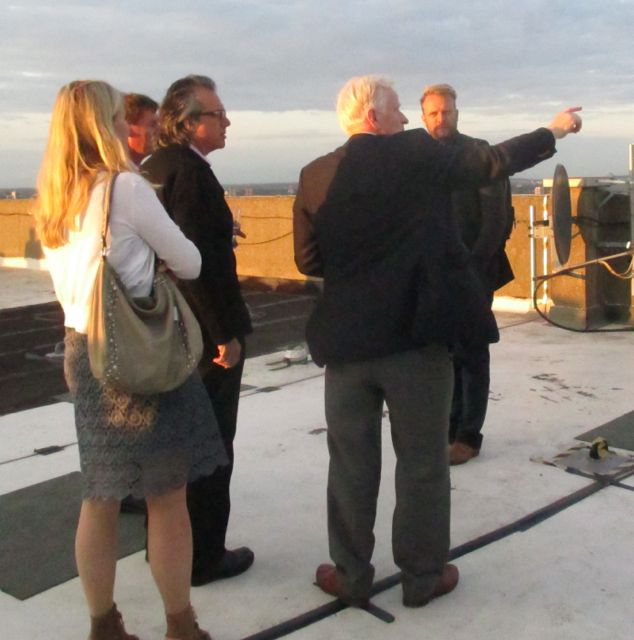Post
The Society visits Balfron Tower
3 Sep 2014
Peter Murray, Chairman of The London Society
I am indebted to Susan Holder who organised the trip to Balfron Tower and sent this report.
In the 1960’s, modernistarchitect Erno Goldfinger lived for a short time in a flat in his 27-storey Balfron Tower in Poplar so that he could get to know the residents and canvas their opinions of his building. Sometimes he would invite them over for a glass or two of champagne and more than 50 years later, on August 20th, the London Society invited members to a get together in another flat on the 24th floor of Balfron Tower but this time a more contemporary tipple was served – a glass of prosecco!
It was a special evening planned and hosted by Ralph Ward of London Urban Visits. As well as the opportunity to look around the surprisingly spacious 1960’s flat we were fortunate to be able to gain a unique insight into the past and future development of the Brownfield Estate (which includes Balfron Tower). We heard from the architect James Dunnett, whose first job was working for Goldfinger; Neal Hunt of Poplar HARCA, the social housing landlord, and Baerbel Schuett of London & Newcastle, the residential property developer who have just begun the joint venture of updating and refurbishing the estate, and Christophe Egret of Studio Egret West who is the architect for the project. We were also joined by sound artist Esther Ainsworth, currently a Bow Arts Trust artist in residence at the Tower.
Born in Hungary Goldfinger spent his early, formative years in Paris where he met and was influenced by the great artists and architects of the period, including Le Corbusier. He came to London in the 1930’s and in the post war years he was awarded his first major commissions to help with the rebuilding of war-damaged London. James reminded us he was over 50 years old when he executed the Brutalist buildings that he is most famous for and thus to some extent they have also become his swan song.
James places Goldfinger alongside Lutyens as one of our greatest modern architects. In fact the two knew each other and both shared a similar reputation for their ‘bullying’ personality, traits which could be rather off putting for those who encountered them lightly (including Ian Fleming who responded by naming one of his villains after the mercurial Hungarian architect).
James told us how he worked on the Brownfield Estate, including the Tower, when he first started in Goldfinger's office, fresh from Cambridge and with a passion for Modernism that had caused him some friction with the prevailing academic mood.
James thinks that the more famous, taller Trellick Tower was a better building as by then they had ironed out and revised many of the problems they encountered with Balfron Tower. One of Goldfinger’s breakthrough ideas was to provide access to the services in a separate tower, which also gives the buildings their distinctive look.
The new developers of the Brownfield Estate then took over to discuss their refurbishment plans but stressed they are committed to keeping the community involved in their plans. Would Goldfinger approve? – probably, and it is a testament to his work that today the estate stands relatively unchanged yet still effective amongst all the development that is happening around it.
The development of the surrounding areas was very obvious when we were escorted upstairs to the roof of Balfron Tower and were able to continue our discussions while enjoying the spectacular panoramic views of East London as well as a different perspective on the tall buildings of the City of London. And a bonus to a very interesting evening was the sunset – and we left with cameras snapping away.
[caption id="attachment_353" align="alignnone" width="297"] Christophe Egret, Baerbel Schuett, James Dunnett on the roof of Balfron Tower[/caption]

